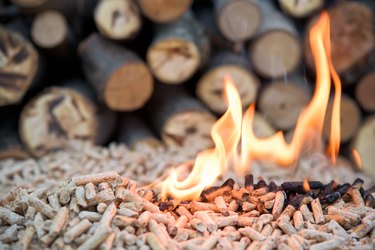
You got a pellet stove to help heat your home, so it can be frustrating to find out that your pellet stove is blowing cold air. There's a fire burning in the stove but the air that is expelled into your home feels like it's never seen a flame. What gives?
A pellet stove has some mechanical parts that can fail, and it takes a little finesse to understand how different adjustments can affect the stove's performance. That means the problem has many potential causes and solutions. Let's take a look at why your pellet stove is not keeping the house warm.
Video of the Day
Video of the Day
Perfecting the Air-to-Pellet Ratio
First things first: If your pellet stove is blowing cold air, make sure the heat setting is not on low. Adjust the heat setting up and see if that solves the problem.
Next, turn your suspicion to the air-to-pellet ratio. This means that an incorrect air flow enters the burn chamber in relation to the amount of pellets being fed into the stove. If the air blowing out of your pellet stove is cool or warm instead of hot, then you may need to open the damper to allow more air into the stove. Alternatively, you may need to increase the pellet feed rate, according to Wood Pellets.
If you can barely get a pellet stove fire to light, then the culprit is certainly low air flow. If you can start a flame but it stays really small or "lazy," then there's no way the stove can blow out hot air. Make sure you're not adding too many pellets as well as getting enough air flow into the stove.
Poor Pellet Quality
In addition to evaluating the air-to-pellet ratio, you'll want to consider aspects that can affect the quality of your pellet stove fire. For example, high-quality pellets will burn better. Look for those made from 100 percent wood, without any bark or filler material. Try to use the manufacturer's recommended pellets for best results, and make sure they aren't too long or damp before adding them to the stove.
Keep the Stove Clean
Regular cleaning is essential for ensuring your pellet stove heats efficiently. A buildup of ash in the stove, for example, will block air flow and reduce the quality of the flame. Some pellet stove models will go into maintenance mode automatically, but this doesn't mean you can ignore some required tasks. For best results, read the owner's manual to understand what you need to do and how often you need to do it.
For example, you'll need to remove ash from the stove every few days. If you have a high pellet feed rate, it may make more sense to remove ash every day. The glass, burn pot and fire walls should also be cleaned on a weekly basis to keep debris to a minimum and encourage a healthy flame.
Pellet Stove Blowing Cold Air
If your pellet stove is blowing cold air even after you've checked the above factors, take a look at the mechanical parts such as the blower and the auger. Do they move like they're supposed to? If not, the parts may need to be cleaned, adjusted or replaced in order to promote a hot pellet stove fire.
If there are any flashing lights on your pellet stove, check the owner's manual to understand what kind of an error code is being displayed. If an electrical component seems to be the problem, be sure to contact a qualified technician to troubleshoot your pellet stove. Anything electrical is best handled by a trained professional for safety purposes, and attempting to fix electrical components yourself may also waive your warranty.